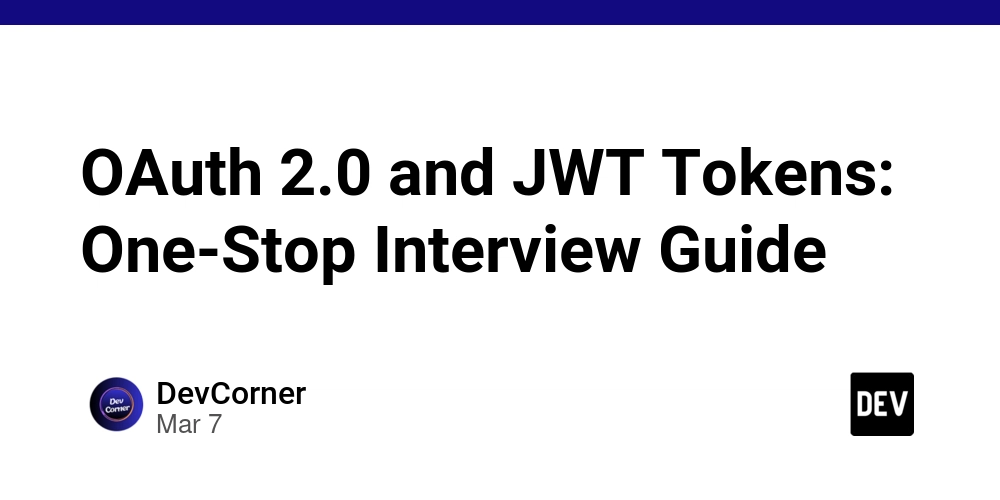OAuth 2.0 and JWT Tokens: One-Stop Interview Guide
Security is a critical aspect of modern web applications. OAuth 2.0 and JWT (JSON Web Tokens) are widely used authentication and authorization mechanisms. This guide provides a detailed, interview-ready explanation of these concepts. 1. What is OAuth 2.0? OAuth 2.0 is an authorization framework that allows third-party applications to securely access user resources without exposing credentials. It enables secure delegated access through access tokens. Key Terminologies: Resource Owner: The user who owns the data. Client: The application requesting access. Authorization Server: Issues access tokens. Resource Server: The API or service that requires authentication. OAuth 2.0 Grant Types OAuth 2.0 provides different flows (grant types) for various use cases: 1️⃣ Authorization Code Flow (Most Secure) Use case: Web applications with a backend server. ✅ Steps: User logs in and authorizes the client. Client receives an authorization code. Client exchanges the code for an access token. Client uses the token to access resources. 2️⃣ Client Credentials Flow Use case: Machine-to-machine (M2M) communication. ✅ Steps: Client authenticates itself with the authorization server. Client receives an access token. Client uses the token to access resources. 3️⃣ Implicit Flow (Deprecated) Use case: Legacy single-page applications (SPA). ✅ Steps: Access token is directly returned in the URL. ⚠️ Not recommended due to security vulnerabilities (e.g., token leakage). 4️⃣ Resource Owner Password Credentials Flow Use case: Trusted applications (not recommended for third parties). ✅ Steps: User provides username and password directly to the client. Client exchanges credentials for an access token. ⚠️ Not recommended due to security risks (password exposure). 2. What is JWT (JSON Web Token)? JWT is a compact, self-contained token used for authentication and information exchange. It is digitally signed to ensure integrity and authenticity. Structure of JWT JWT consists of three parts: Header: Contains metadata (e.g., signing algorithm) { "alg": "HS256", "typ": "JWT" } Payload: Contains claims (user data, roles, expiration) { "sub": "1234567890", "name": "John Doe", "exp": 1710000000 } Signature: Ensures the token hasn’t been tampered with HMACSHA256( base64UrlEncode(header) + "." + base64UrlEncode(payload), secretKey ) JWT example: HEADER.PAYLOAD.SIGNATURE Types of JWTs: Access Tokens: Short-lived tokens for accessing resources. Refresh Tokens: Long-lived tokens used to obtain new access tokens. 3. OAuth 2.0 vs JWT Feature OAuth 2.0 JWT Purpose Authorization framework Token format Usage API authentication Stateless authentication Storage Can use JWT or opaque tokens Self-contained token Expiration Short-lived tokens Expiration embedded Signature Not mandatory Mandatory for integrity 4. Securing OAuth 2.0 and JWT

Security is a critical aspect of modern web applications. OAuth 2.0 and JWT (JSON Web Tokens) are widely used authentication and authorization mechanisms. This guide provides a detailed, interview-ready explanation of these concepts.
1. What is OAuth 2.0?
OAuth 2.0 is an authorization framework that allows third-party applications to securely access user resources without exposing credentials. It enables secure delegated access through access tokens.
Key Terminologies:
- Resource Owner: The user who owns the data.
- Client: The application requesting access.
- Authorization Server: Issues access tokens.
- Resource Server: The API or service that requires authentication.
OAuth 2.0 Grant Types
OAuth 2.0 provides different flows (grant types) for various use cases:
1️⃣ Authorization Code Flow (Most Secure)
Use case: Web applications with a backend server.
✅ Steps:
- User logs in and authorizes the client.
- Client receives an authorization code.
- Client exchanges the code for an access token.
- Client uses the token to access resources.
2️⃣ Client Credentials Flow
Use case: Machine-to-machine (M2M) communication.
✅ Steps:
- Client authenticates itself with the authorization server.
- Client receives an access token.
- Client uses the token to access resources.
3️⃣ Implicit Flow (Deprecated)
Use case: Legacy single-page applications (SPA).
✅ Steps:
- Access token is directly returned in the URL.
⚠️ Not recommended due to security vulnerabilities (e.g., token leakage).
4️⃣ Resource Owner Password Credentials Flow
Use case: Trusted applications (not recommended for third parties).
✅ Steps:
- User provides username and password directly to the client.
- Client exchanges credentials for an access token.
⚠️ Not recommended due to security risks (password exposure).
2. What is JWT (JSON Web Token)?
JWT is a compact, self-contained token used for authentication and information exchange. It is digitally signed to ensure integrity and authenticity.
Structure of JWT
JWT consists of three parts:
- Header: Contains metadata (e.g., signing algorithm)
{
"alg": "HS256",
"typ": "JWT"
}
- Payload: Contains claims (user data, roles, expiration)
{
"sub": "1234567890",
"name": "John Doe",
"exp": 1710000000
}
- Signature: Ensures the token hasn’t been tampered with
HMACSHA256(
base64UrlEncode(header) + "." + base64UrlEncode(payload),
secretKey
)
JWT example:
HEADER.PAYLOAD.SIGNATURE
Types of JWTs:
- Access Tokens: Short-lived tokens for accessing resources.
- Refresh Tokens: Long-lived tokens used to obtain new access tokens.
3. OAuth 2.0 vs JWT
| Feature | OAuth 2.0 | JWT |
|---|---|---|
| Purpose | Authorization framework | Token format |
| Usage | API authentication | Stateless authentication |
| Storage | Can use JWT or opaque tokens | Self-contained token |
| Expiration | Short-lived tokens | Expiration embedded |
| Signature | Not mandatory | Mandatory for integrity |









































































































































































![[The AI Show Episode 142]: ChatGPT’s New Image Generator, Studio Ghibli Craze and Backlash, Gemini 2.5, OpenAI Academy, 4o Updates, Vibe Marketing & xAI Acquires X](https://www.marketingaiinstitute.com/hubfs/ep%20142%20cover.png)


























































































































![[FREE EBOOKS] The Kubernetes Bible, The Ultimate Linux Shell Scripting Guide & Four More Best Selling Titles](https://www.javacodegeeks.com/wp-content/uploads/2012/12/jcg-logo.jpg)



![From drop-out to software architect with Jason Lengstorf [Podcast #167]](https://cdn.hashnode.com/res/hashnode/image/upload/v1743796461357/f3d19cd7-e6f5-4d7c-8bfc-eb974bc8da68.png?#)







































































































.png?#)




.jpg?#)




















 (1).webp?#)











_Christophe_Coat_Alamy.jpg?#)








































































































![Rapidus in Talks With Apple as It Accelerates Toward 2nm Chip Production [Report]](https://www.iclarified.com/images/news/96937/96937/96937-640.jpg)








































































































































